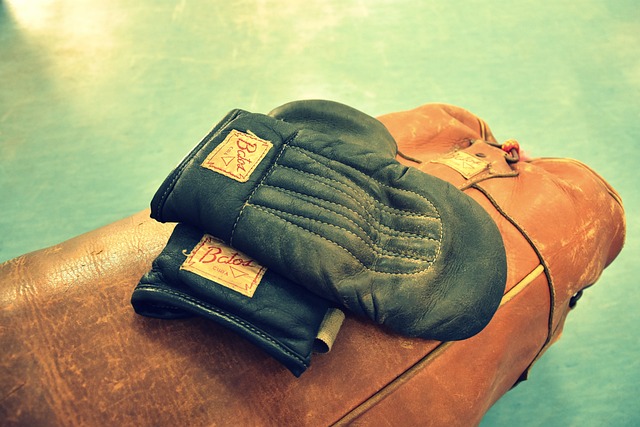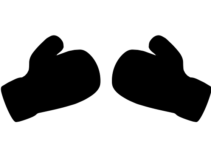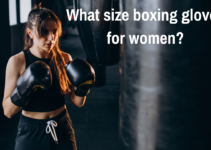Boxing gloves are an essential piece of equipment for boxers of all levels, serving to protect both the fighter’s hands and their opponent’s head and body.
But can boxing gloves be too big?
However, one important factor to consider when selecting a pair of boxing gloves is their size. While it may seem like bigger is better when it comes to gloves, there is a limit to how large they can be before they become ineffective or even dangerous.

In this blog, we will explore the question of whether boxing gloves can be too big, discussing the potential drawbacks of oversized gloves and the importance of choosing the right size for your needs.
Can boxing gloves be too big?
Yes, boxing gloves can be too big. When boxing gloves are too big for a person’s hand, it can make it difficult to form a proper fist, which can lead to ineffective punches and even injuries.
In addition, oversized gloves can create an uneven playing field in competitions or sparring sessions, which can be dangerous for both parties.
Therefore, it’s important to choose the right size of boxing gloves for your hand and purpose.
Now lets look at 15 reason why boxing gloves can be too big?
15 reason why boxing gloves can be too big
There are many potential reasons why boxing gloves can be too big. Here are 15 possible factors to consider:
- Improper sizing: One of the most common reasons for oversized gloves is simply choosing the wrong size. If a fighter’s hand size is not taken into account when selecting gloves, they may end up with gloves that are too large for their hands.
- Padding: Some gloves may have thicker or denser padding than others, which can make them feel bulkier or heavier.
- Brand variation: Different brands of gloves may have different sizing and padding standards, which can lead to variations in size.
- Purpose: Gloves designed for sparring or training may be bulkier than those designed for competition, as they are meant to provide extra protection during practice.
- Injury prevention: Some fighters may opt for larger gloves to help prevent hand injuries, such as fractures or sprains.
- Comfort: Some fighters may find that larger gloves feel more comfortable or provide a better fit for their hands.
- Hand wraps: The size and thickness of a fighter’s hand wraps can affect how gloves fit, with thicker wraps potentially making gloves feel tighter.
- Style: Some fighters may prefer the look of larger gloves or feel that they enhance their image as a fighter.
- Weight class: As mentioned earlier, fighters in heavier weight classes may require larger gloves to meet weight class regulations.
- Safety regulations: Certain competitions or organizations may have specific rules regarding glove size that must be followed.
- Glove condition: Over time, gloves can become worn or stretched out, which can make them feel larger than their original size.
- Personal preference: Ultimately, glove size is a matter of personal preference for many fighters, and some may simply prefer larger gloves.
- Training type: The type of training or sparring being performed may impact glove size, with heavy bag training potentially requiring larger gloves than speed bag work.
- Hand shape: The shape and size of a fighter’s hands can impact how gloves fit, with some fighters needing larger gloves to accommodate wider hands or longer fingers.
- Hand injuries: Fighters with existing hand injuries may need to wear larger gloves to protect their hands and avoid aggravating the injury during training or competition.
Weight class
In boxing, weight classes are used to ensure that fighters compete against opponents of similar size and weight.

There are currently 17 weight classes recognized by major boxing organizations, ranging from minimumweight (up to 105 pounds) to heavyweight (over 200 pounds).
The weight class that a fighter competes in is determined by their weight at the official weigh-in before the fight.
When it comes to boxing gloves, the size and weight of the gloves can vary depending on the weight class of the fighters.
Generally speaking, heavier weight classes will require larger and heavier gloves to provide adequate protection for both fighters.
For example, in the heavyweight division, the standard weight for boxing gloves is 10 ounces, whereas in the lower weight classes, such as flyweight or bantamweight, fighters may wear gloves as light as 8 ounces.
However, just because a fighter is competing in a heavier weight class does not mean that they can wear gloves that are too big.
In fact, oversized gloves can actually be detrimental to a fighter’s performance and safety, as they can make it difficult to form a proper fist and deliver effective punches.
Therefore, it is important for fighters in all weight classes to choose gloves that fit properly and provide the right amount of protection for their hands and their opponents.
What fits best
Everyone’s hands are different, and they move differently depending on their anatomy. That means that when it comes to boxing gloves, everyone is going to have a unique experience.
On top of that, the gloves themselves can vary in a lot of ways, which only adds to the variability.
So, how do you choose the right gloves for you? Well, one factor to consider is your hand circumference. If you have small hands between 5.5 and 6.5 inches, then 8 oz gloves are a good choice.
Fighters with hands between 6.5 and 7.5 inches in circumference should go for 10 oz gloves. Between 7.5 and 8.5 inches, they could acquire 12 oz gloves, and between 8.5 and 9.5 inches, 14 oz gloves are recommended.
To measure your hand circumference, choose your dominant hand, wrap it in hand wraps, and measure its widest part, including the thumb.
It’s a good idea to try on multiple pairs of gloves and punch with them if possible before making a purchase. Despite what others may suggest, it’s important to choose a pair that feels comfortable on your hands.
When trying on gloves, make sure that your fingertips only touch and don’t press against the top of the gloves. The fit should be snug, but not so tight that it restricts blood circulation. You need to be able to close your fist without any restrictions.
At the end of the day, your comfort is what matters most when it comes to selecting the right pair of gloves.
So, listen to your body and let it guide your decision. With the right pair of gloves, you’ll be able to train and compete safely and comfortably.
Fighting style:
Your fighting style plays a big role in choosing the right size of boxing gloves. If you’re all about speed and throwing lightning-fast strikes, you want to steer clear of gloves with a boxy shape and lots of foam padding concentrated over the knuckles.
These gloves will only weigh you down and slow you up, which is the last thing you need if you’re a speed demon.
When you’re all about speed, you don’t need tons of padding over your knuckles since you’re not throwing super hard punches.
On the other hand, if you’re a heavyweight hitter who likes to throw serious power, you’ll want to go for bigger gloves with thick padding over your knuckles and the back of your fist.
When you’re trading speed for power, you need all the protection you can get.
No matter what size gloves you choose, be sure to lace them up or tighten the Velcro straps securely around your wrists.
This keeps the gloves from slipping or turning over on your hands, which can lead to improper contact with your target. And that’s no good for anyone involved!
The inner foam
One factor that can make boxing gloves feel too big is the amount of inner foam. You see, boxing gloves have foam padding inside to cushion your hands and protect your knuckles during a fight.
But if there’s too much foam, it can make the gloves feel bulky and awkward.
When gloves have a lot of foam padding, they tend to be more suitable for sparring or training, rather than actual fights.
That’s because the extra padding can absorb more impact and reduce the chances of serious injury during training sessions. But in a real fight, that extra padding can slow you down and make your punches less effective.
On the other hand, if there’s not enough foam padding, your hands and knuckles may not be adequately protected during training or fights. This can lead to injuries like sprains, fractures, and bruises.
That’s why it’s essential to choose the right gloves with the appropriate amount of foam padding for your needs.
For example, if you’re a beginner, you may want to start with gloves that have more foam padding to protect your hands as you’re learning proper technique.
But as you become more experienced, you may want to switch to gloves with less foam padding to increase your speed and power.

Ultimately, the key is to find a balance between protection and performance. You want gloves that fit comfortably, offer sufficient padding, and allow you to throw punches with speed and accuracy.
So, when choosing your gloves, pay attention to the amount of inner foam and how it affects the overall size and feel of the gloves.
Related FAQ’s
Are boxing gloves supposed to be big?
Yes, boxing gloves are supposed to be big, but not too big. The size of the gloves is important because they provide protection for your hands and your opponent’s face during a fight.
Boxing gloves typically range in weight from 8 ounces to 16 ounces, and the size you choose depends on your weight and the purpose of the gloves.
For example, if you’re a lightweight fighter, you might choose a smaller glove like 8 or 10 ounces, whereas if you’re a heavyweight fighter, you might choose a larger glove like 14 or 16 ounces.
The gloves are also designed to fit snugly on your hands, so they don’t slip or move around during a fight. This helps to prevent injuries to your hands and wrists, and it ensures that your punches land accurately on your opponent.
However, it’s important to remember that gloves that are too big can actually be more harmful than gloves that are too small.
If the gloves are too big, they can slip off your hands or move around during a fight, which can cause you to hit your opponent with the wrong part of your hand, leading to injuries like broken fingers or wrists.
So, while boxing gloves are supposed to be big, it’s important to choose the right size and fit for your weight and fighting style.
A properly fitting glove will provide the right amount of protection and allow you to perform at your best during a fight.
Are bigger boxing gloves safer?
While bigger boxing gloves can provide more padding and protection for both the wearer and their opponent, it’s not always the case that they’re safer.
The safety of boxing gloves depends on several factors, including the size, weight, and quality of the gloves, as well as how they’re used during a fight.
Bigger gloves may offer more padding over the knuckles, which can reduce the impact of a punch and help to prevent injuries.
However, if the gloves are too big or not properly fitted, they can slip off the wearer’s hands or move around during a fight. This can lead to the wearer accidentally hitting their opponent with the wrong part of their hand, causing injuries like broken fingers or wrists.
Additionally, wearing larger gloves can also lead to a false sense of security and encourage boxers to throw harder punches than they would with smaller gloves. This can increase the risk of head injuries for both the wearer and their opponent.
Ultimately, the safety of boxing gloves depends on a combination of factors, including the size, weight, and quality of the gloves, as well as the skill and experience of the fighters.
It’s important to choose gloves that fit properly, are made of high-quality materials, and are appropriate for the weight and skill level of the boxers.
Proper technique and training are also essential for minimizing the risk of injuries during boxing matches.
Are bigger or smaller boxing gloves better?
The answer to whether bigger or smaller boxing gloves are better depends on the individual boxer and their specific needs.
Bigger gloves generally provide more padding and protection, which can be beneficial for beginners or boxers with weaker hands who are looking to reduce the risk of injury.
They can also be beneficial for sparring sessions, where the emphasis is on practicing techniques rather than landing hard punches.
On the other hand, smaller gloves allow for more speed and agility, which can be advantageous for boxers who rely on quick movements and want to maximize their punching power.
They also provide a better feel and connection to the target, allowing for more precision in punches.
The weight of the gloves is also a factor to consider. Heavier gloves can help build endurance and strength, while lighter gloves are better for improving speed and accuracy.
Ultimately, the choice between bigger or smaller gloves depends on the individual boxer’s goals and preferences.
It’s important to consider factors like hand size, skill level, and intended use when selecting the right size and weight of gloves.
It’s also important to choose high-quality gloves that fit properly and provide adequate protection for the boxer’s hands and their opponent.
How big should my boxing gloves be?
Are my gloves too big?
It’s important to make sure your boxing gloves fit properly to ensure optimal performance and protection during training or fights.
If your gloves are too big, they can slide around on your hands, which can be distracting and also impact your punching accuracy.
One way to tell if your gloves are too big is if they feel loose or if you can move your hand around inside them. If the gloves are not snug on your hand, they may not offer the support and protection you need during training or fights.
Another sign that your gloves may be too big is if your fingertips are touching the end of the glove.
Your fingertips should only lightly touch the top of the glove, not press against it, to ensure proper fit and comfort.
If you’re unsure about whether your gloves are the right size, try testing them out during training to see how they feel.
If you notice any discomfort or difficulty using them, you may want to consider trying on a different size. Remember, proper fit is essential for both safety and optimal performance in the ring.
Are 16 oz gloves way too big?
The size of boxing gloves is typically chosen based on the weight of the boxer and the type of training or competition they will be participating in. 16 oz gloves are considered to be a larger size, and are often used for sparring and training purposes.
While 16 oz gloves may feel bulky or cumbersome to some boxers, they are not necessarily “way too big.” In fact, the size and weight of the gloves can provide added protection for both the boxer wearing them and their sparring partner.
It’s important to note that the size of the gloves should be appropriate for the individual boxer’s needs and preferences.
Some boxers may prefer lighter gloves for certain types of training or competition, while others may prefer the added padding and protection of larger gloves.
Ultimately, the choice of glove size should be based on a variety of factors, including the boxer’s weight, level of experience, and training goals, as well as any rules or regulations that apply to the specific training or competition setting.
Conclusion:
In conclusion, the size of boxing gloves is an important consideration for boxers of all levels and can impact both performance and safety.
While 16 oz gloves are a larger size and may feel bulky or cumbersome to some boxers, they are not necessarily “way too big.”
The size and weight of gloves should be chosen based on a variety of factors, including the boxer’s weight, level of experience, and training goals, as well as any rules or regulations that apply to the specific training or competition setting.
Ultimately, the choice of glove size should prioritize the boxer’s comfort, protection, and ability to perform to the best of their abilities.






